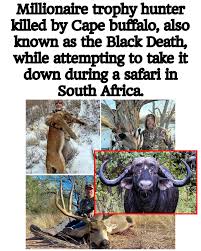
Introduction: A Tragic Reminder of Hunting Risks
In a shocking event that underscores the dangers associated with hunting, a well-experienced hunter was killed by a cape buffalo in a remote part of Zimbabwe’s hunting grounds. This incident not only serves as a cautionary tale for hunters but also raises discussions about wildlife management and conservation. The cape buffalo, known for its unpredictable nature and strength, poses significant risks to those who pursue it, often leading to serious injuries or fatalities during hunting expeditions.
The Incident: Details and Context
The incident occurred late last week when the hunter, an American tourist with several years of experience, was on a guided hunt in the Gonarezhou National Park, a region known for its diverse wildlife and scenic landscapes. During the hunt, the hunter reportedly approached the buffalo, which is part of the ‘big five’ game animals sought by hunters. In an unexpected turn of events, the buffalo charged, leading to the fatal injury of the hunter.
Local authorities have stated that the hunter was with a licensed guide when the incident happened, underscoring the importance of having experienced personnel during such dangerous pursuits. Nevertheless, even seasoned hunters can encounter unforeseen challenges, especially with large and aggressive wildlife like the cape buffalo.
Reactions and Conservation Implications
The tragedy has sparked outrage and concern within both the hunting community and wildlife advocacy groups. Critics argue that such hunting practices threaten wildlife preservation efforts and question the ethical aspects of trophy hunting. Many wildlife experts emphasize the need for stricter regulations and better educational programs for hunters regarding the behavior of large game animals they may encounter.
Cape buffaloes are known for their unpredictable nature; they are aggressive, especially when they feel threatened or cornered, which makes hunting them particularly perilous. This unfortunate event has reignited a debate on whether trophy hunting contributes positively to conservation efforts or exacerbates the risk to both human lives and animal populations.
Conclusion: A Call for Caution in Hunting Practices
The death of the American hunter serves as a sobering reminder of the inherent dangers of hunting, particularly in regions where wildlife interactions can be deadly. As the hunting community grapples with the fallout from this incident, it is vital for hunters to prioritize safety and respect for wildlife. Moving forward, these discussions around regulation, ethics, and safety in hunting practices will be critical to ensuring both the protection of human lives and the sustainable management of wildlife populations.



